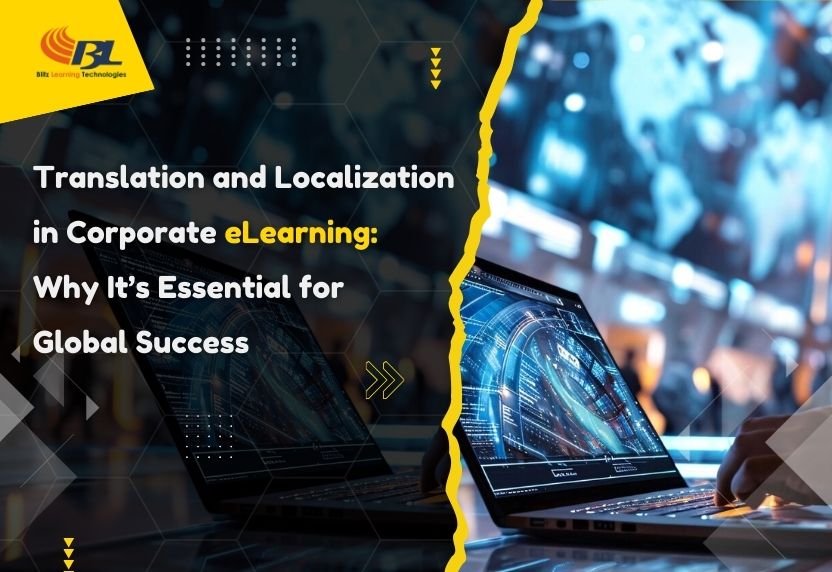
Blog
- Home
- Blog

23Oct
Translation and Localization in Corporate eLearning: Why It’s Essential for Global Success
Introduction
As the corporate world becomes increasingly global, businesses are constantly looking for ways to effectively train, upskill, and engage employees across various regions. With eLearning becoming a cornerstone of corporate training, one key factor in ensuring its success is the translation and localization of content. Simply put, translating training materials is no longer enough. To truly connect with diverse workforces, organizations need to embrace localization, which tailors content to specific cultural and regional contexts.
The Difference Between Translation and Localization
Before diving into why localization is critical in corporate eLearning, it’s important to understand the distinction between translation and localization:
- Translation refers to converting text from one language to another. It’s a direct linguistic process that focuses on conveying the same message in a different language. While essential, translation alone doesn’t account for cultural or regional nuances.
- Localization goes a step further. It involves adapting not just the language but also the cultural, visual, and contextual elements of the content to make it more relatable and relevant to the target audience. This includes modifying imagery, tone, examples, and even units of measurement to ensure the message resonates deeply with local learners.
Why Localization is Critical for Corporate eLearning
1. Improving Learner Engagement: Employees are more likely to engage with eLearning content when it feels relevant and relatable. Localized content considers the cultural norms, values, and communication styles of different regions. By using local references, idioms, and examples, learners are more likely to connect with the material, resulting in higher engagement and retention rates.2. Enhancing Training Effectiveness: For training to be effective, learners need to fully understand and relate to the content. For example, compliance training may involve legal concepts that differ between countries, or health and safety guidelines that vary across regions. Without localization, these critical differences may be overlooked, leading to confusion or incorrect applications. Localization ensures that content is accurate and contextually appropriate, leading to better training outcomes.
3. Building Inclusivity: Global organizations are made up of diverse employees with different cultural backgrounds, languages, and values. Providing localized eLearning content shows a commitment to inclusivity and respect for diversity. It creates an equal learning opportunity for all employees, regardless of their location, which can help foster a more cohesive and empowered workforce.
4. Boosting Brand Alignment: When employees receive training that reflects the company's values and mission in a culturally sensitive way, they feel more aligned with the company’s overall vision. Localization ensures that the tone, visuals, and messaging of eLearning courses are consistent with the brand but also tailored to regional sensibilities. This boosts both the effectiveness of the training and the emotional connection employees have with the brand.
5. Complying with Local Regulations: In many regions, corporate training must adhere to specific laws and regulations. Whether it's labour laws, compliance standards, or industry-specific rules, localized content ensures that employees are trained in alignment with local legal requirements. This not only protects the company from potential legal issues but also ensures that employees can operate safely and effectively in their specific work environments.
How to Approach Localization in eLearning
To successfully localize corporate eLearning content, a strategic approach is needed:
1. Start with a Global Mindset: When creating eLearning content, always consider how it might be adapted for different regions. Designing with localization in mind from the start—using clear, concise language and avoiding culturally specific references—can make the localization process smoother and more efficient.2. Use Native Linguists and Localization Experts: Localization is not just about converting words; it’s about conveying meaning in a way that’s culturally appropriate. Partnering with native-speaking linguists who understand the local culture, language, and corporate environment is critical for ensuring accuracy and relevance.
3. Adapt Multimedia Elements: Localization involves more than just text. Videos, images, graphics, and even user interfaces may need to be adjusted to suit the cultural preferences of the target audience. For example, colors, symbols, and even humor may carry different meanings in different regions. Ensure that multimedia elements are just as carefully localized as the language itself.
4. Leverage Technology for Efficient Localization: Modern eLearning platforms often come with built-in localization tools that allow for easier content management across multiple languages and regions. Translation management systems (TMS) and learning management systems (LMS) with localization features can streamline the process, ensuring that updates to content are quickly and consistently applied across all localized versions.
5. Test and Validate with Local Audiences: After localizing content, it’s essential to test it with real users in the target region. This validation ensures that the content is not only linguistically accurate but also culturally relevant and engaging. Gathering feedback from local employees can help identify areas for improvement and ensure that the training program will resonate effectively.
Conclusion
In a world where businesses are increasingly global, localization is no longer optional—it’s essential for effective corporate eLearning. By going beyond simple translation and adapting content to align with local languages, cultures, and contexts, companies can ensure that their training programs resonate deeply with all employees, regardless of geography.
As the eLearning industry continues to evolve, companies that invest in localized training solutions will not only improve employee engagement and performance but also build a more inclusive, culturally aware workforce. The result? A more connected, agile, and successful global enterprise.




Leave a comments